Cardiac Rehabilitation Exercise Programme Information for Participants
Please note, this page is printable by selecting the normal print options on your computer.
Welcome to Your Exercise Programme
Your exercise classes will take place at the Physiotherapy gym found at entrance 6 at Milton Keynes University Hospital (Yellow Zone). Please wait in the Physiotherapy reception on arrival. Classes run on either Monday 12:30 – 13:30 or Wednesday 12:30 – 13:30. You will be allocated a day and date to start during your pre exercise assessment. Your exercise programme will run over 8 weeks and you will be allocated consecutive sessions. If you miss any sessions these might not be reallocated therefore it is in your best interests to attend as many of the sessions as possible.
What to bring with you:
All you will need during your exercise class is:
• Your GTN spray/tablets (if you have been given them)
• Your blood glucose monitor (if you are diabetic)
• Fast acting bronchodilator (if you are asthmatic)
• A bottle of water
• Glasses if you wear them
• You may also wish to bring a small towel
• Non-restrictive clothing / Flat supportive shoes /no open toed footwear
What Will Happen In The Class?
The class will follow the same format every time, as described below:
• Check in (approx 5 -10 mins)
• Warm up (approx 15 mins)
• Main exercise (approx 25 mins)
• Cool down (approx 10 mins)
• Check out (approx 5 mins)
For your safety, it is important to inform us of any changes in symptoms, changes in medication or treatment before you exercise. Also, if you have been feeling unwell (if you are taking antibiotics, have chest discomfort, excessive shortness of breath, coughs, colds, stomach upsets, discomfort in joints or muscles). During the sessions you must remember to keep your feet moving whenever possible. This rule should apply to all three phases of your exercise sessions (warm-up, main and cooldown). This has important implications for your blood pressure and the amount of work that your heart has to do. For this reason, please do not stand around – keep your feet moving.
Why is physical activity so important?
Exercise
Regular exercise is known to improve health and can improve the long-term prognosis of people who develop Cardio-Vascular disease by improving cardiovascular fitness and assisting with risk
factor modification. Current guidelines state that to gain health benefits we all need to do physical activity on most days of the week, at a moderate intensity level for at least 30 minutes. However, the problem for many people who develop Heart Disease is that they are unsure of what types of exercise are safe for them to do and they may lack confidence about how to reintroduce and adapt their usual fitness programme.
Attending a Cardiac Rehabilitation Exercise programme can help you to improve your cardiovascular fitness, suppleness, balance, strength and stamina. We will provide you with the information to enable you to continue with a fitness programme of your own choice. You are 26% more likely to live longer if you attend a Cardiac Rehabilitation exercise programme, and have an improved quality of life.
Health related benefits, especially for someone with heart disease (or someone with a high risk of heart disease), are the following:
• Increased exercise threshold for the onset of chest pain (angina)
• Improved cholesterol levels
• Lower blood pressure
• Improved blood sugar control
• Lower anxiety and depression
• Improved ability to perform daily activities
• Increased confidence and sense of well-being
• Improved rate of return to work and leisure activities
• Fewer visits to the doctor and hospital
• Reduced dependence on cardiac drugs
• Improved feelings about being able to cope after a heart attack or surgery.
What is even more encouraging is that these changes are possible with light to moderate exercise. So don’t panic – we aren’t going to make you run marathons! Your exercise programme will be
designed around you, your needs and your capabilities, and will gradually progress as you gain in fitness and confidence. During the sessions you will be taught how to use the various pieces of
equipment and how to exercise safely and effectively.
How Often Should I Be Exercising to Gain Health Benefits?
We get most benefit from doing physical activity on a regular basis, rather than just once or twice a week. In order to gain the maximum benefit to your health, you should aim to do at least 30
minutes of physical activity on 5 or more days per week. So, even though you are starting the supervised exercise sessions it is very important that you continue with your regular activity at home on other days. Remember, these 20 to 30 minutes does not include your warm up and cool down so make sure you leave enough time so you don’t have to rush the exercises. Your weekly plan could include activities such as gardening or housework or walking to the local shop. You can split up your 30 minute activity session – for example you could do 15 minutes of housework twice
a day.
Additional activity recommendations
It may be that you are keen to resume other leisure activities or hobbies, such as swimming or golf. Our advice would be to continue walking regularly, but do not attempt any other leisure activities before first discussing it with a member of staff. Once you have completed some of the supervised rehabilitation sessions, and we have had a chance to assess your fitness levels and
exercise capabilities, we will then be happy to give you guidance about other suitable activities. At the back of this folder you will find a physical activity diary. We recommend that you record your
exercise and activity for the period that you attend our classes, and also details of how you feel and whether you are experiencing any problems. If you wish, staff will be able to review your diary
during the programme. Keeping the diary will give you an accurate and useful record of the progress that you are making.
Sensible Precautions
• Do remember to start any exercise or physical activity slowly and gradually build up – you will not benefit from doing too much too soon.
• Do “warm-up” before starting the active exercise regime.
• Do always allow time for your body to cool down after exercise.
• Do carry your (GTN) spray or inhaler with you whilst exercising if you have one.
• Do monitor your blood sugars and take a starchy carbohydrate snack with you, if you are a diabetic.
• Do wear non-restrictive, comfortable clothing and wear sensible, well fitting & supportive footwear.
• Do keep your legs or toes moving when you are standing during activities.
• Do not exercise during illness or infection, including the common cold.
• Do not exercise for two hours after eating a large meal.
• Do not begin to exercise if you are very hungry.
• Do not drink alcohol before or after exercise.
• Do not have a very hot or cold shower or sauna after exercise. They can lower your blood pressure and make you feel lightheaded and dizzy.
• Do not perform long sustained actions especially with your arms raised above your head, for example pushing a car or lifting very heavy objects.
• Do not hold your breath when exercising.
• Do not continue to exercise if you feel any chest discomfort/tightness: stop and use your GTN as directed.
• Do not continue to exercise if you have any symptoms unusual for you; e.g. severe breathlessness, dizziness, nausea, palpitations, muscle cramps or extreme or unusual fatigue.
Exercise Structure
You should always think of any activity you are doing as a three-part process. Warming up and cooling down are just as important as the main activity itself.
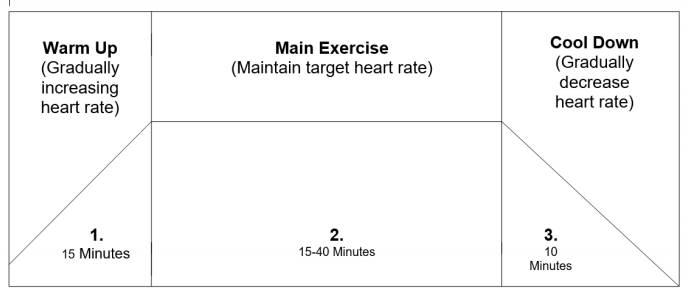
Warm Up
What is a Warm-Up?
• Warm up is a period of gentle activity, which prepares the body for the activities that will follow.
• The warm-up should last at least 10 – 15 minutes.
Why Warm Up?
• To mobilise the joints that will be used in exercise by slowly increasing their range of movements.
• To gradually raise the heart rate by using large muscle groups.
• To stretch the main muscle groups, holding each stretch for 10 seconds, to avoid muscle strains.
Warm Up Advice:
• Keeping the feet moving is essential
• You should feel comfortable that the exercise is easy to continue.
• If you find you are working too hard reduce the level as necessary.
• Hold onto a stable object if necessary.
• If you need to sit down – continue the warm-up in a sitting position.
• Whilst stretching you should feel a slight stretch in the muscle – it should not be painful
• Continue breathing as normal throughout – do not hold your breath
• Hold the stretch for 10 seconds – do not bounce!
Cool Down
The cool down should last about 10 minutes. It is important because a gradual cool down lessens the risk of a post-exercise drop in blood pressure and irregular heartbeats. After you have completed the circuit of exercises, walk around gently to cool down. Stretching during the cool down helps to reduce any muscle soreness that may be caused by the activity. The aim of the cool down is to bring your body back to its resting state gradually.
Stretches
Here are some stretches to include in the warm up and cool down during the exercise session:
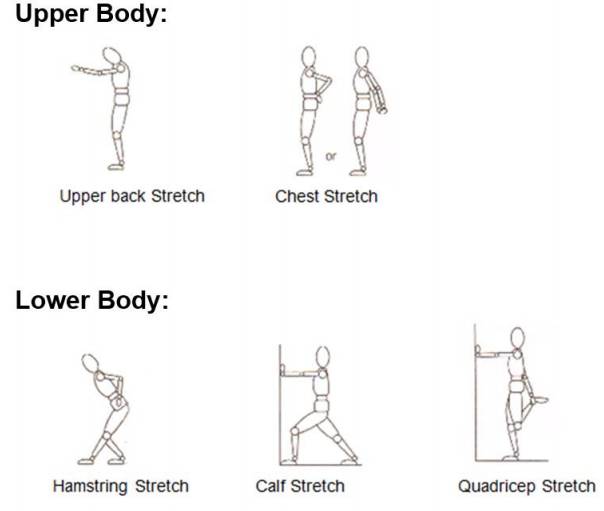
How Hard Should I Be Working?
Monitoring your exercise level
It is important to make sure that you are not pushing your body too hard, but also that you are working hard enough to achieve the benefits that have been discussed. During the programme we
will show you how to check how hard you are working so that you are able to exercise safely and effectively, both in a supervised setting and on your own.
Effort score
While exercising we want you to rate your perception of exertion, i.e. how heavy and strenuous the exercise feels to you. The perception of exertion depends mainly on the strain and fatigue in your
muscles and your feeling of breathlessness or aches in the chest. Look at this rating scale; we want you to use this scale from 6 – 20, where 6 means “no exertion at all” and 20 means “maximal
exertion”. Look at the scale and the expressions and then give a number:
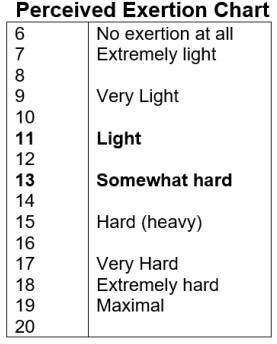
Try to appraise your feeling of exertion as honestly as possible; without thinking about what the actual physical load is. Don’t underestimate it, but don’t overestimate it either. It’s your feeling of
effort and exertion that’s important, not how it compares to other people. What other people think is not important either. Ideally at this stage of your recovery we would like you to be working at a level that corresponds to ‘moderate – fairly hard’ (level 3-4). If you would describe your effort level as hard/strenuous, then you are working too hard and need to slow down. You must be completely honest and try to be as accurate as possible. This is a useful way of checking your activity levels and keeping within comfortable limits.
Talk test
This is another simple way of assessing how hard you are working. Try having a conversation while you are exercising. If you are able to speak in complete sentences and are only a little out of
puff, then you are working at the correct level. If you find yourself gasping and short of breath, then you are working too hard and need to slow down.
Safety Advice
Please read and follow these safety guidelines:
1. What should I do if I experience any pain while exercising?
STOP whatever you are doing, no matter where the pain is coming from. You should never experience any pain during or after physical activity. IF YOU ARE IN THE MIDDLE OF A REHABILITATION CLASS, TELL ONE OF THE MEMBERS OF STAFF IMMEDIATELY.
2. Are there any other reasons that I should stop exercising?
Yes, you should listen to your body and stop exercising immediately if you experience any of the following:
• Pains or tightness in the chest
• Pain, swelling, stiffness in joints
• Palpitations
• Excessive sweating
• Excessive shortness of breath
• Sickness/nausea
• Feeling dizzy or faint
Please let one of the cardiac rehabilitation staff know IMMEDIATELY if you are experiencing any of these problems.
It is also important that you stick to the prescription that is given to you. If you feel that you are capable of walking or pedalling faster than your programme indicates, do not just increase your programme yourself. Instead, talk to a member of the rehabilitation team, and we will tell you if we think it is appropriate and safe for you to do so.
3. What should I do if I have angina when I am exercising on my own?
Angina is an uncomfortable feeling in the chest. It usually feels like a heaviness or tightness in the centre of the chest, which may spread to the arms, neck, jaw, face, back or stomach. Use your GTN spray or tablets, (if you have been given these) because this will increase the supply of blood to your heart and help to relieve the discomfort.
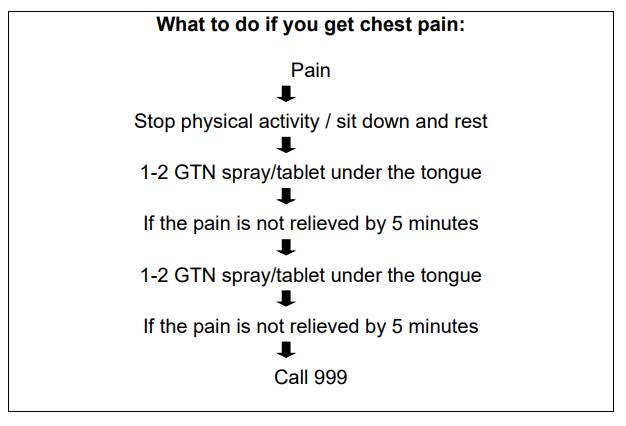
If at any point your pain becomes worse, or if you feel unwell (e.g. dizzy, sweaty, short of breath) please call 999 for an ambulance immediately. If your pain is relieved, but if the episodes of angina are more frequent or are taking longer to go away, please arrange to see you GP to be reviewed. If you notice that your angina has started to happen at night or when you are resting, it is important that you see your GP so that he/she is aware of your new symptoms.
References
The information in this booklet is based on evidence. The following references were used:
Association of Chartered Physiotherapists in Cardiac Rehabilitation. Standards for Physical Activity and Exercise in the Cardiovascular Population. 3rd Edition; London: ACPICR;2015.
Borg, G (1998) Borg’s Perceived Exertion and Pain Scales. Human Kinetics. Champaign, Illinois.
British Association for Cardiovascular Prevention and Rehabilitation. The BACPR Standards and Core Components for Cardiovascular Disease Prevention and Rehabilitation 3rd Edition. London: British Association for Cardiovascular Prevention and Rehabilitation; 2017.
Department of Health (2000) National Service Framework for Coronary Heart Disease. DOH.
Chapter 7
Throw, M. (2006) (Ed) Exercise Leadership in Cardiac Rehabilitation: An evidence-based
approach.
Whurr Publishers Limited. Chichester.
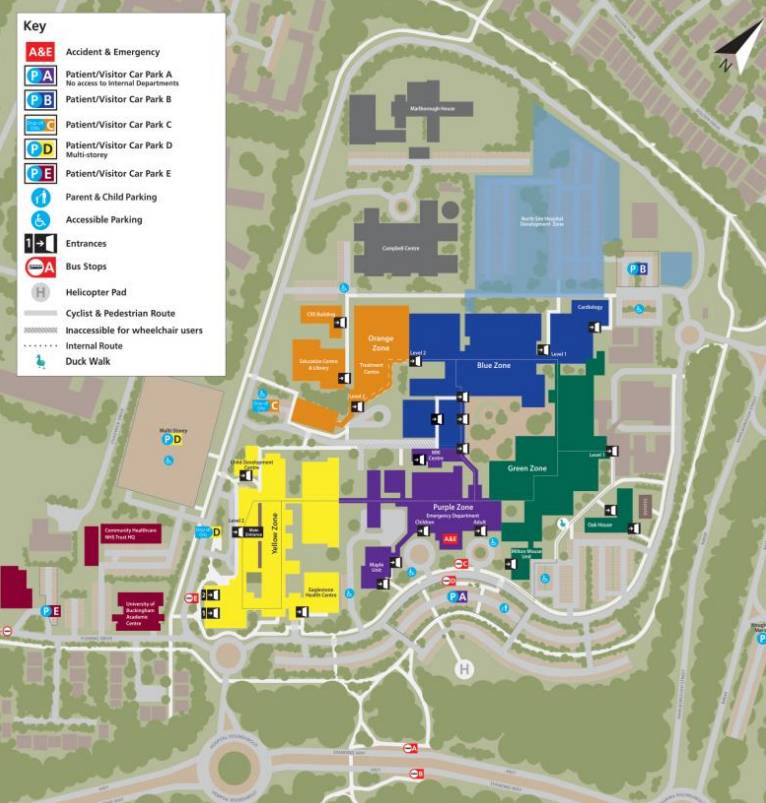
The Physiotherapy reception is located in the yellow zone, shown above.
Safety Considerations for Sessions at The Gym
In order to make sure you are safe during your exercise session, please read through the following information carefully:
While you are being checked in it is your responsibility to tell your Cardiac rehabilitation team about any illness / symptoms that you have had since you last attended the class and inform us of any changes to your medication.
If at any point during your exercise programme you feel uncomfortable/ unhappy to continue with the activity, stop immediately and tell a member of staff.
If you are in any doubt about these instructions, please check with a member of staff before starting the activity.
If you experience any pain or discomfort (chest pain/muscular pain) you must tell a member of staff immediately
Welcome to The Exercise Programme
We Hope That You Enjoy Your Exercise Sessions
